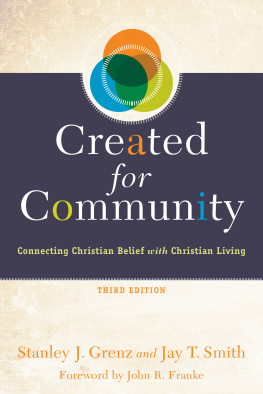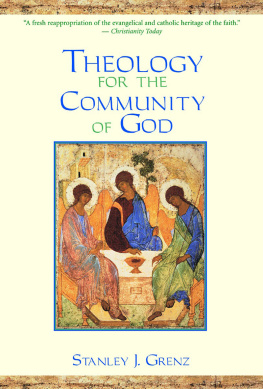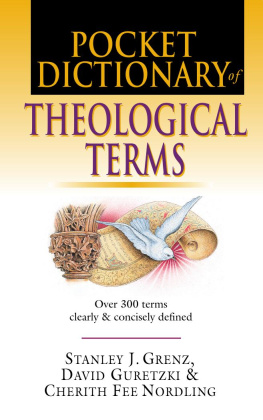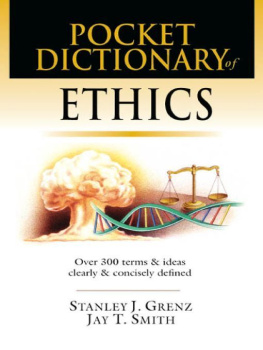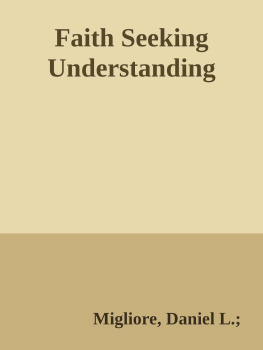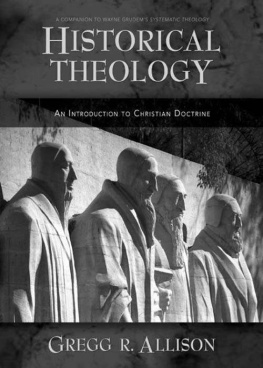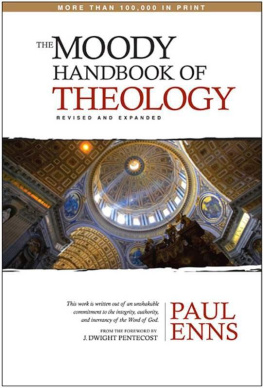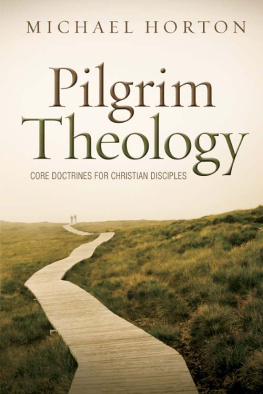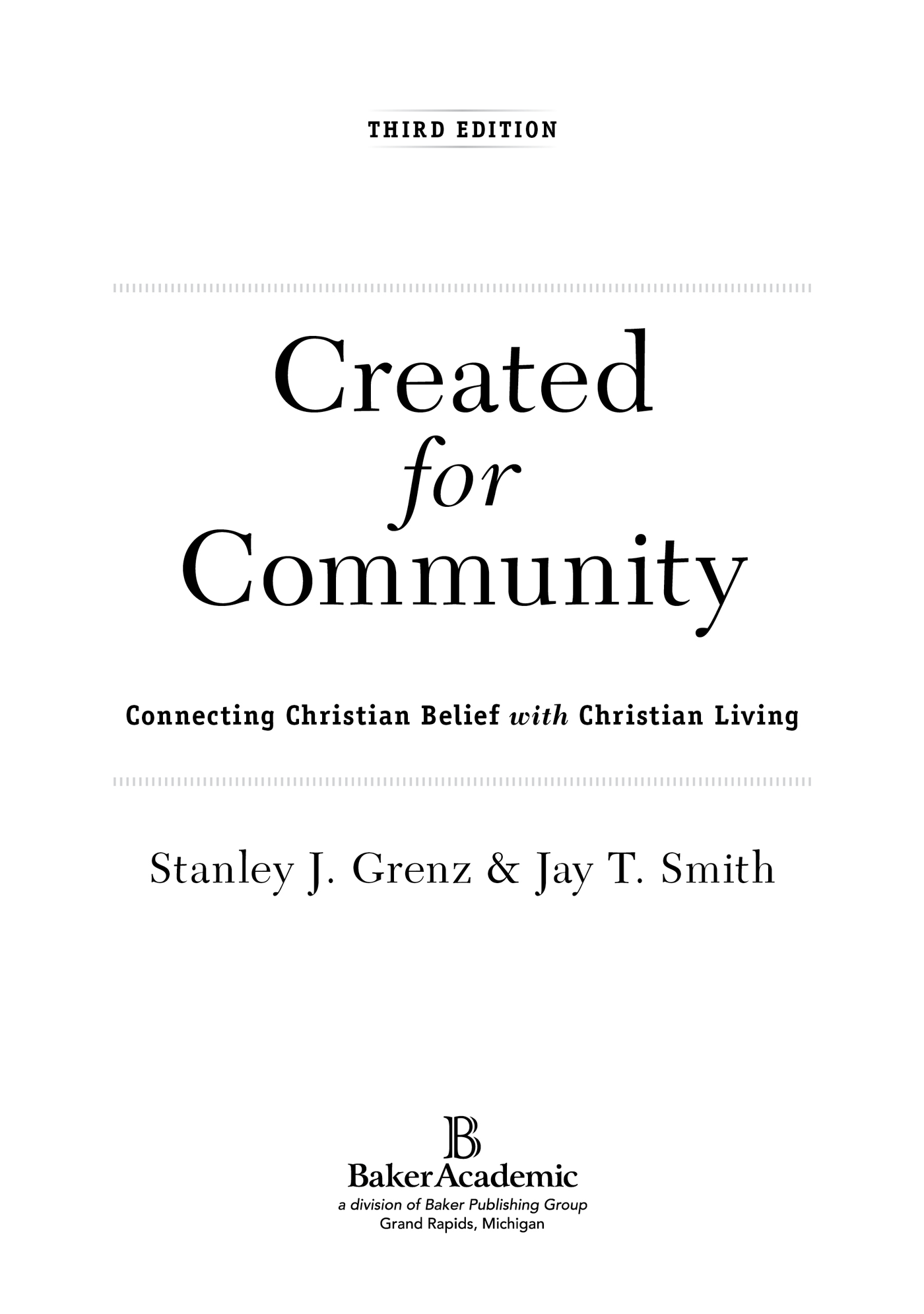
1996, 1998, 2014 by Stanley J. Grenz and Jay T. Smith
Published by Baker Academic
a division of Baker Publishing Group
P.O. Box 6287, Grand Rapids, MI 49516-6287
www . bakeracademic . com
Ebook edition created 2015
Ebook corrections 10.10.2016
All rights reserved. No part of this publication may be reproduced, stored in a retrieval system, or transmitted in any form or by any meansfor example, electronic, photocopy, recordingwithout the prior written permission of the publisher. The only exception is brief quotations in printed reviews.
Library of Congress Cataloging-in-Publication Data is on file at the Library of Congress, Washington, DC.
ISBN 978-1-4412-2056-1
Unless otherwise indicated, Scripture quotations are from the Holy Bible, New International Version. NIV. Copyright 1973, 1978, 1984, 2011 by Biblica, Inc. Used by permission of Zondervan. All rights reserved worldwide. www.zondervan.com
Scripture quotations labeled NASB are from the New American Standard Bible, copyright 1960, 1962, 1963, 1968, 1971, 1972, 1973, 1975, 1977, 1995 by The Lockman Foundation. Used by permission.
Scripture quotations labeled NRSV are from the New Revised Standard Version of the Bible, copyright 1989, by the Division of Christian Education of the National Council of the Churches of Christ in the United States of America. Used by permission. All rights reserved.
To Roger E. Olson
Scholar, Educator, Friend
In Memory of Stanley J. Grenz
Contents
Cover
Title Page
Copyright Page
Dedication
Foreword John R. Franke
Preface to the Third Edition
Preface to the Second Edition
Introduction: Christian Belief and Christian Living
1. Knowing the God of the Bible in the Contemporary World
2. The God Whom We Know
3. Our Identity as Gods Creatures
4. Our Human Failure
5. Jesus Christ: God with Us
6. Jesuss Mission in the Divine Program
7. The Holy Spirit: The Author of Life
8. The Holy Spirit and Our Salvation
9. The Pioneer Community
10. Participating in the Pioneer Community
11. The Climax of Our Story
12. Gods Community: Our Eternal Home
Epilogue: Making the Connection
Postscript Jay T. Smith
Resources for Further Study
Glossary
Subject Index
Scripture Index
Notes
Back Cover
Preface to the Third Edition
In 2015, the theological vision of Stanley Grenz continues to be meaningful and challenging for both the inquisitive seeker and the post-conservative evangelical. Roughly ten years after his untimely passing at the age of fifty-five, Grenzs work has spawned numerous doctoral dissertations and theses from inspired young theologians seeking to embody the erudition and ethos that was Stanley Grenz. I am one of those students. I met Stan Grenz in the summer of 1998 and moved to Vancouver to study with him at Regent College, where I was his teaching and research assistant from 1999 to his untimely death in 2005. His understanding of convertive piety as trinitarian participation shaped my own doctoral work. In both my life and work, I am indebted to Stans love of God, of the church, and of the theological task.
This revised edition of Created for Community contains a new foreword by Dr. John R. Franke. Dr. Franke was Grenzs coauthor for Beyond Foundationalism , the provocative construal of evangelical theological method in a postmodern context. Additionally, Franke has taken Grenzs method and ethos to the next level with his construal of missional theology. For many, myself and John Franke included, Grenzs work not only stimulates and invigorates our own theological projects but also serves to enrich our daily spiritual lives. This is one of the enduring qualities of his workit is both theologically engaging and spiritually encouraging. Not many theologians can make that claim. The parsing of theology into a variety of subdivisions, such as systematic, practical, historical, and spiritual, has had the effect of segregating the intellectual from the spiritual. Not so in Grenzs work. By his own estimation, Grenz was a pietist with a PhD, and all of his readers will benefit from that understanding.
The body of Created for Community basically remains as Stan wrote it, with a few notable changes, including footnotes with references to his other works and updated cultural references. The discussion questions have been updated and expanded as well. This edition also contains a bibliography of Grenzs works and a postscript. The goal of this edition is to provide more resources and access to Grenzs work for both serious laypersons and undergraduate theology students. Many thanks go to Bob Hosack and Christina Jasko at Baker Academic for their commitment to this project. Bob, a longtime friend of Stan Grenz, is committed to Stans vision of a generous theology, and Christina is a patient and insightful editor. Without both of them, this project would still be a dream.
Both John Franke and I dedicate this new revision to Stan Grenz and the generations of students yet to be touched by his life and theological vision.
Preface to the Second Edition
Peppermint Patty was describing to Charlie Brown the exam she took in school that day. One question on the test read, How many angels can stand on the head of a pin? Peppermint Patty queried her friend as to how a person could answer such a question. True to form, Charlie Brown offered an astute, carefully crafted explanation. He informed Patty that her teacher had posed an old theological problem, for which there is no answer. Oblivious to her friends display of theological acumen, Peppermint Patty expressed her dismay. She had answered, Eight, if theyre skinny, and four if theyre fat!
Many people cringe at the thought of reading a theology book. They are convinced that theologians are stuffy academic types who hang out in ivory towers where they discuss obscure, unknowable, and irrelevant questions like the one posed to Peppermint Patty. Unfortunately, many theologians provide ample support for this stereotype. They are sometimes content to argue with each other about issues that are of no concern to most people, even to most Christians. And they often give the impression that their discussions have no bearing on life in the real world. Nothing, however, could be further from the truth. Theology is by its very nature connected to life. Each of us, regardless of religious affiliation (or lack of it), has a core set of beliefs (a worldview) about God and the world (or ultimate reality). And these beliefs form the foundation for how we live.
This book is about theology, and more specifically, Christian theology. It sets forth my understanding of the core beliefs we share as believers. My goal is to make theology accessible to people who are reticent to read a theology text. More specifically, I want to survey the Christian theological landscape with you, so that you might sharpen your core set of beliefsnot for the sake of priming you to win theological arguments but to assist you to live as a Christian in the society in which God has placed you so that you can connect Christian belief with Christian living.
The theme around which this book revolves is given in the title, Created for Community . At the heart of the Christian message is the good news that the Triune God desires to bring us into fellowship with himself, with each other, and with all creation. I believe that this biblical vision of communitythis core set of beliefscan provide the foundation for truly Christian living, as we are drawn by the Holy Spirit to live on the basis of this vision.

